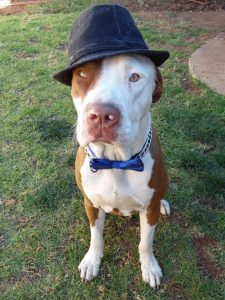Originally published November 7, 2014

In part 1, we discussed how to introduce your adult dog to a new dog. This time I want to discuss the importance of socialization between your dog and other people.
Socialization of Dogs and People
Dogs are social creatures. By their nature, they usually get along well with people: unless they have reason not to. Any animal that is abused by a person can learn to mistrust, avoid, and fear people. That’s a blanket statement, so it is true only in the most general terms. If a dog knows only its abuser, then she will most likely fear all people. If a dog is abused by a man, but his wife is kind to her, she may well fear only men. An abusive teenager with kind and gentle (though not very attentive) parents may instill a socialization age bias.
Puppies
Socialization of a puppy is pretty simple: once he’s had all his shots and the vet gives you the OK, simply expose the puppy to other people in a positive way. Rarely will a puppy pick up a disease from a person, but if these people also have a dog, this is a danger to your puppy. Begin this socialization as early as you can, so the pup doesn’t become fixated on you. Normally, puppies are very friendly and gregarious; socializing with people should not be an issue. Making interaction with other people a regular part of their life will keep them that way.
Adult Dogs
Socialization of an adult dog to new people can be considerably trickier, depending on the dog’s situation and history. When a dog comes to us from the local shelter, we rarely know much about his history. He’ll be either a stray that was picked up and never claimed, or an owner-surrender. If a stray, we know nothing about history. If an owner-surrender we know only what they chose to tell the shelter staff… and that may not be truthful.
When Jenifer (from the local shelter) asks us to take in one of the shelter’s dogs, she tells me what they know, and gives me her impressions of the dog based on her interactions with him or her. She does a fine job of assessing these dogs. Most of our canine guests come in for treatment of Heartworms. Behavioral issues, if any, are mild and secondary. But there have been a few who came in specifically for behavior mods or social issues. Those with people-social issues are generally a result of abuse or severe neglect.
What causes a dog to become unfriendly?
Abuse is one cause for a dog to become people-unfriendly, but another is simply lack of socialization. Those who live in a remote area and receive few visitors can foster an aggressive attitude in a dog who knows no one but his family: especially if this dog takes on the role of protector for the family. If that role is encouraged by his family, they actually train the dog to be aggressive. Illness can also make a dog aggressive. Being sick, especially a long-term problem makes us grumpy; it will do the same for a dog.
Socialization of an Adult Dog with People
If you find you have a dog who is, or has become, unfriendly toward people, here is how to go about correcting that. But first: determine if the unfriendliness is directed at all outsiders or just one. I have found that dogs are better judges of people than are most people. If your dog takes a strong dislike to just one person, there may be a good reason for it.
Second, assess the dog’s breed: some breeds are more aloof than others. Some are naturally timid, while others are known to be gregarious. Many of today’s breeds are bred to have specific attributes. If your dog is a mix of several breeds, this may be a guessing game, but look at the predominant breed for clues.
Is the aggression territorial? When Cochise is at home he will put on a show of terrible ferocity and heinous threats toward visitors. This was particularly true while he was confined by a tether when outdoors. Since a fence was installed and he has a large yard to run in, he has been less terrorizing. And when we take him out in public, he is just a big cuddle-baby. He is super friendly to everyone, though because he is a 90 pound American bulldog, he inadvertently intimidates some of those he bounds up to and asks for skritchies or a belly rub.
Cochise’s territorialism is largely due to a lack of visitors here, and was augmented by frustration at being tethered. Correcting this started with providing this big dog with a proper place to run off his energy. We’re continuing by inviting friends and neighbors to visit with him through the fence, then in the yard, and eventually in our home. The next step will be to train him for a “stand-down” command that tells him this person has our permission and approval to be here. We don’t want him to be welcoming of all strangers. A large noisy dog is a good deterrent for casual thieves.
If his aversion was toward people in all places, the remedy would be to take him somewhere that other people will be present, but at a distance: like a public park. Keep him leashed, take toys and treats. The trick here is to distract him with a game of tug, some light wrestling, or some other play that he likes and will distract his attention from the people around him. Take a break once in a while and let him notice the people. If he gets anxious, don’t sooth him: that comes across as rewarding his behavior. Instead, distract him again.
If he does well, reward him with praise and a treat. As he becomes more accepting arrange for someone to approach and speak with you from a safe distance. Have them address the dog as well. Reward good behavior, back away and re-set if he reacts badly.
As these socialization exercises continue, begin walking your dog among people. Do not let people corner your dog. A dog on a leash may feel cornered even with a lot of space around because the dog can’t get away. If someone is pushy about approaching to pet your dog and won’t listen to your instructions, call your dog and take a few steps backward (which will turn your dog around) keeping your dog’s focus on you. You may appear snobbish, but it’s good for the dog! It tells your dog that YOU will deal with the humans, and that you are a leader worthy of his trust.
Here are some general pointers offered by Kathy Diamond Davis, the author of the book Therapy Dogs: Training Your Dog to Reach Others.
In socializing your dog, you want to create positive experiences with every variation on the human condition you possibly can. Here are some differences to use:
- Accustom your dog to people of as many different appearances as possible. This includes people who are tall, short, narrow, wide, bearded, short-haired, long-haired, and with skin all the colors of the rainbow. Whatever differences you and your dog come across, your goal is to teach the dog that these things are not important.
- Get your dog used to people who smell different ways. Being in my 20th year as a therapy dog handler, I’ve come to believe that dogs are not as put off by scents as people are. If you don’t like the way someone smells, you may notice it makes no difference to your dog. What you don’t want to do is react in such a way that your dog will be afraid of that scent.
- Let your dog get used to people moving in all sorts of ways. That means walking, running, limping, riding a bicycle, skating, skipping, and anything else you can think of or find. Keep in mind the dog’s comfort and safety so your dog will have good experiences with these movements, not bad ones.
- Accustom your dog to all sorts of sounds associated with people. That includes whispering, talking, laughing, coughing, singing, yelling, playing music electronically or with an instrument and all the other variations you can arrange.
- Give your dog the experience of people appearing suddenly. This is startling to some dogs, so start at a distance and be prepared to distract the dog with an eye contact exercise (see Eye Contact.)
- Expose your dog to people wearing a wide variety of clothing.
- Get your dog used to people carrying all kinds of objects. A safe distance from a construction site is a convenient place to work on this.
- When you can actively work with your dog when someone comes to your home, this is a great opportunity to get your dog used to people in a potentially delicate situation. If you’re not able to actively control the dog, though, put the dog into an area away from being able to see the visitors. You don’t want any bad habits or beliefs to get started.
Ideally, your dog will be friendly and welcoming toward people you treat with friendliness. Protective behavior should be initiated only on a command from you. Keeping your dog socialized means taking him or her with you into public places, or having lots of people into your home. Isolate a dog and they lose that socialization pretty quickly.
If your dog’s anti-social behavior does not respond to these techniques, seek the help of a professional trainer. If you don’t know of any in your area, ask your veterinarian for a recommendation.
| If you enjoy our updates, Doggy Tales, and educational articles consider subscribing for notices when new pieces are posted. It’s painless and you can unsubscribe any time you want. Your e-mail address is used ONLY to deliver these notices. | [email-subscribers namefield=”YES” desc=”” group=”Public”] |



